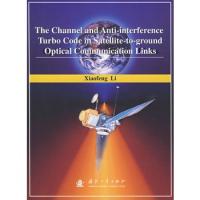| 定价: | ¥ 35 | ||
| 作者: | 李晓峰 著 | ||
| 出版: | 国防工业出版社 | ||
| 书号: | 9787118055924 | ||
| 语言: | 英文原版 | ||
| 日期: | 2008-03-01 | ||
| 版次: | 1 | 页数: | 172 |
| 开本: | 16开 | 查看: | 0次 |

| 服务商城 | 客服电话 | 配送服务 | 优惠价 | 购买 |
| 400-711-6699 | 满29至69元,免运费! | ¥26.3 |
The book, with a name of "The Channel and anti-interference Turbo code in satellite-to-ground optical communication links", is based on a set of lecture notes prepared for a first-year graduate course on the principle and technology of optical communication links, given in the University of Electronic Science and Technology of China (UESTC) for the past several years. Lots of contents (especially refer to the theory and theoretic model) in this book are excerpted from the published references which were vended by the experts and scholars in domestic and overseas. This book labels the references cited as much as possible. However, because of restriction of different reasons, it is difficult to ensure that there is no omission and error, and hope learners of insight to criticize and make comment.
Preface
List of Abbreviations
1 Introduction
1.1 Introduction
1.2 The characteristics of the wireless optical communication links
1.3 The kinds of the laser beam
1.4 The main problems in satellite-to-ground optical communication links
1.5 The kinds of the satellite-to-ground optical communication links
1.6 Equation of the satellite’to-ground optical communication links
2 The introduction of atmosphere
2.1 Atmospheric scope
2.2 Atmospheric components
2.3 Atmospheric layers
2.4 A brief review of atmospheric turbulence
2.5 The refractive index of the turbulence atmosphere
2.6 The basic concept of the structural function
2.7 The analytical models of the phase structure function
2.8 The basic characteristics of satellite-to-ground channel
3 The effects of attenuation
3.1 The cause of the effect of attenuation
3.2 The physical interpret of the absorption effect
3.3 The physical interpret of the scattering effect
3.4 Bougner-Lambert’s law equation
3.5 Beer’s law equation
4 The turbulence effects
4.1 The definition of some important parameters
4.2 Introduce of the power spectrum models of turbulent flow
4.3 The refractive index structure function
4.4 Hufnagel-Valley (H-V) model
4.5 Scintillation
4.6 The angle-of-arrival fluctuation
4.7 The beam spreading
5 The aperture averaging
5.1 The definition of the aperture averaging
5.2 The basic principle of the aperture averaging
5.3 The aperture averaging factor
5.4 The factors that affect the aperture averaging factor
6 Digital modulation
6.1 Amplitude Shift Keying-ASK
6.2 Frequency shift keying-FSK
6.3 Phase Shift Keying-PSK
7 The basic theories of code
7.1 The basic principle
7.2 The classification of error correcting code
7.3 Block code, linear code, linear block code
7.4 Convolutional code
8 Turbo code
8.1 Introduction
8.2 The structure of the turbo codes
8.3 The principle of the turbo encoder
8.4 The component encoder
8.5 The Puncturing
8.6 Interleaver versus received optical power
Reference
List of Abbreviations
1 Introduction
1.1 Introduction
1.2 The characteristics of the wireless optical communication links
1.3 The kinds of the laser beam
1.4 The main problems in satellite-to-ground optical communication links
1.5 The kinds of the satellite-to-ground optical communication links
1.6 Equation of the satellite’to-ground optical communication links
2 The introduction of atmosphere
2.1 Atmospheric scope
2.2 Atmospheric components
2.3 Atmospheric layers
2.4 A brief review of atmospheric turbulence
2.5 The refractive index of the turbulence atmosphere
2.6 The basic concept of the structural function
2.7 The analytical models of the phase structure function
2.8 The basic characteristics of satellite-to-ground channel
3 The effects of attenuation
3.1 The cause of the effect of attenuation
3.2 The physical interpret of the absorption effect
3.3 The physical interpret of the scattering effect
3.4 Bougner-Lambert’s law equation
3.5 Beer’s law equation
4 The turbulence effects
4.1 The definition of some important parameters
4.2 Introduce of the power spectrum models of turbulent flow
4.3 The refractive index structure function
4.4 Hufnagel-Valley (H-V) model
4.5 Scintillation
4.6 The angle-of-arrival fluctuation
4.7 The beam spreading
5 The aperture averaging
5.1 The definition of the aperture averaging
5.2 The basic principle of the aperture averaging
5.3 The aperture averaging factor
5.4 The factors that affect the aperture averaging factor
6 Digital modulation
6.1 Amplitude Shift Keying-ASK
6.2 Frequency shift keying-FSK
6.3 Phase Shift Keying-PSK
7 The basic theories of code
7.1 The basic principle
7.2 The classification of error correcting code
7.3 Block code, linear code, linear block code
7.4 Convolutional code
8 Turbo code
8.1 Introduction
8.2 The structure of the turbo codes
8.3 The principle of the turbo encoder
8.4 The component encoder
8.5 The Puncturing
8.6 Interleaver versus received optical power
Reference





 粤公网安备 44030902003195号
粤公网安备 44030902003195号